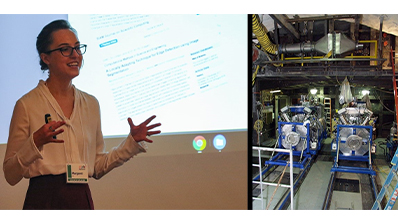National security may not be the first career field that comes to mind for mathematics students. However, mathematicians play a vital role in experiment design and analysis at the Nevada National Security Site (NNSS), and they’re working to ensure younger generations know how their skillset can influence work within the National Nuclear Security Administration (NNSA).
Applied mathematics is exercised at the NNSS in multiple facets, including radiography; multimodal sensing, which utilizes multiple layers of detection techniques to grid activity (in this case, radiological activity); experimental and optical diagnostics; and MIE scattering, which uses light lasers to make determinations about elements used in experiments. Data from these methods are used to make decisions for the Stockpile Stewardship program, which ensures the nation’s nuclear stockpile remains safe, reliable and secure through subcritical science experiments. Data are also used for Nuclear Nonproliferation programs, which work to prevent the spread of nuclear weapon technologies.
“There’s always someone needing something analyzed,” said Marylesa Howard, NNSS signal processing and applied mathematics scientist. “We find math in every place we look. There’s a lot coming down the pipeline that we can start getting involved in by spreading our bandwidth and our depth of knowledge.”
Since 2015, Howard has served with the Mathematical Association of America’s Preparation for Industrial Careers in Mathematical Sciences program. As an industrial liaison, she educates university students and faculty about research opportunities at the NNSS. One challenge is breaking down perceptions that pursing statistics automatically means a career in actuary work at places like insurance companies or Wall Street. Another is recruiting younger generations quickly enough to have crossover time with careered NNSS scientists and mathematicians.
“It’s essential to capture as much existing knowledge now to pass on to the younger workforce,” said Howard. “We are in such a specialized field of nuclear science where most people don’t have that breadth of knowledge when they come in from school. You have to start training the next generation now to glean as much knowledge and wisdom from the senior employees before they retire.”
The NNSS works to recruit candidates from across the nation for progressive internship opportunities that are the foundation for a career. These include undergraduate, cooperative education (enabling students to earn academic credit through their work at the NNSS), post-baccalaureate, graduate research assistant and post-doctoral programs.

Former intern Maggie Lund began her journey in mathematics with the Site in 2014 while between undergraduate and graduate school; she is now a senior scientist at the NNSS and conducts radiography analysis using Cygnus, a dual-axis flash X-ray radiography system located at the NNSS’ U1a Complex. By compiling series of images produced from Cygnus, Lund is able to reconstruct what occurs during subcritical experiments and use statistical models to compute material densities.
“My plan for life was not at all to go in this route,” said Lund. “It was serendipitous, really. I hadn’t even heard of the NNSS until one of my computer science professors announced the NNSS was looking for interns. It was my first taste of real research. It was so cool to work on one of these projects with a team of mathematicians. To see a team of people create new methods and understand the physics in order to find solutions was entirely new to me. I knew I needed to be a part of this—I need to be out in the field doing these experiments.”
Lund returned to the NNSS during summers as she continued her education with her masters in statistics and doctorate in applied mathematics. During that time, she had her doctoral research funded by the NNSS and became a published author in theJournal of Applied Physics and Society of Industrial and Applied Mathematics’ Journal on Computational Science and Engineering. Outside of the NNSS, Lund is working to inspire some of the community’s youngest leaders-to-be about possibilities through STEM. She recently spoke with the Girl Scouts of Southern Nevada about the influential roles that women have at the NNSS.
“I think girls are now exposed to so many more new things than I was,” said Lund. “Young women today are exposed to people in the field who can help encourage them on the path that they’re already interested in. Mathematicians can do something other than teach.”
For students interested in pursuing an internship or career with the NNSS, Howard says key qualifications are having strong programming and linear algebra skills. She’s also looking for individuals who can speak about their discipline to various levels of an organization and make connections about how work integrates with other subject matter experts.
“Working at the NNSS has introduced me to so many different fields of science and engineering,” said Lund. “It has challenged me as a mathematician and professional scientist in so many ways. It is something that I would recommend to anyone.”

